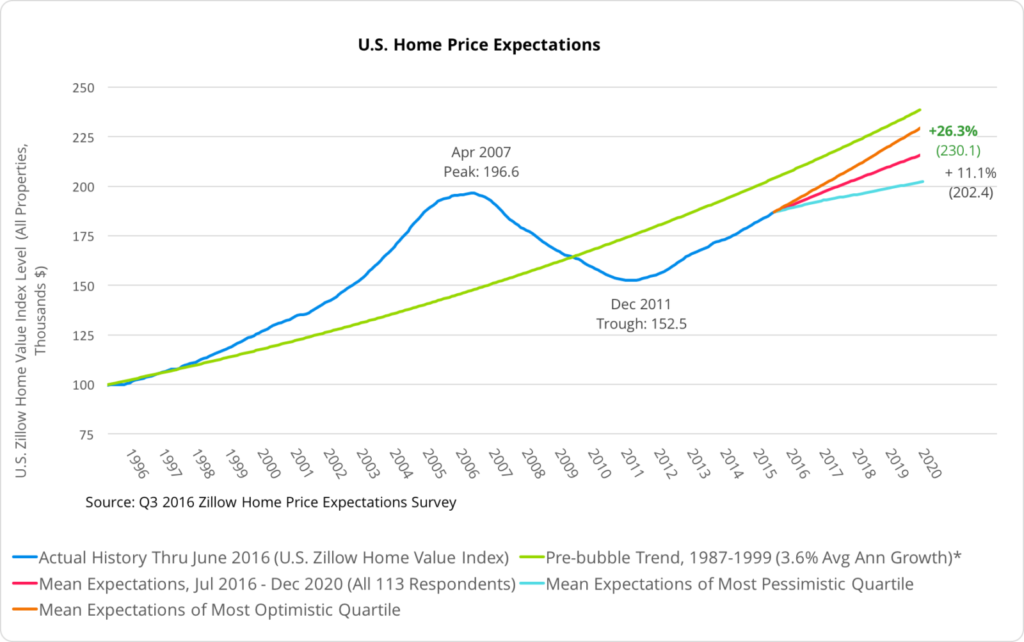Experts: New Job Growth Expected to Drive Migration Back to Middle America
A marked shift in fortunes between coastal America and Middle America since the housing recovery began – rapid growth in the former, stagnation in the latter – is likely to eventually reverse as cost-conscious companies look for cheaper places to grow, according to a panel of more than 100 experts.
 •
Aug 10 2016
•
Aug 10 2016
- Panelists surveyed by Zillow said they expected home values to end 2016 up 4.5 percent year-over-year, on average, and for the median U.S. home value to exceed its pre-recession peak by November 2017.
- A majority of panelists with an opinion said markets in the middle of the country were likely to regain popularity compared to coastal markets in coming years as cost-conscious employers start creating more jobs in Middle America.
A marked shift in fortunes between coastal America and Middle America since the housing recovery began – rapid growth in the former, stagnation in the latter – is likely to eventually reverse as cost-conscious companies look for cheaper places to grow, according to a panel of more than 100 experts.
The Q3 Zillow Home Price Expectations Survey, sponsored by Zillow and administered by Pulsenomics LLC, asked a panel of 113 economic and real estate experts nationwide to offer their expectations for home value growth through 2020. The survey also asked the experts to share their views and expectations on changing dynamics in the middle of the country versus the coasts and in urban versus suburban communities.
Coasts vs. Heartland; Cities vs. Suburbs
Since the housing boom and bust gave way to recovery, the U.S. housing market has seemingly split into two unequal parts: Middle America, and coastal America. Home values are growing rapidly in markets on both coasts as hot job markets help keep demand for housing high, and more slowly in the Midwest and Heartland – where negative equity is still pervasive and job growth scant. As a result, Americans – especially younger millennials – are moving away from Middle America and to the coasts in large numbers, whether for jobs, lifestyle preferences or both.
But more than half of those experts with an opinion (56 percent) said they believed this trend has either already begun to reverse or will reverse in coming years. Another 11 percent said this trend was actually an illusion, and that coastal markets are no more or less popular now than they’ve always been relative to Middle America. Just 25 percent of experts with an opinion said the coastal/Middle America split was likely to be permanent.
Of those experts who said the trend was likely to reverse, a majority (56 percent) said job growth in the middle of the country – driven by companies looking for cheaper alternatives to the coasts in which to expand – would eventually lure residents back to the Heartland. Similarly, almost a quarter (24 percent) said Americans would migrate inland in search of more affordable housing and 13 percent said Americans will start to seek the more traditional lifestyle that the middle of the country has to offer. Only 2 percent said climate change is likely to force residents away from the coasts.
In addition to the coastal/inland divide, the U.S. housing market has also experienced a notable shift between urban and suburban communities. The suburban home – long a symbol of success, stability and the American Dream – appears to be losing some of its luster as urban homes grow in value more quickly. Panelists were asked if they believed this swing was permanent, temporary or overstated. A majority of those with an opinion (57 percent) said the shift was temporary and that suburbs were already regaining popularity or were likely to in coming years. The same portion of respondents (22 percent) said the shift was permanent as those that said the trend was overstated.
Home Value Expectations: New Highs by Late 2017
On average, panelists said they expected home values to end 2016 up 4.5 percent year-over-year, a bump in expectations from 4 percent annual growth for this year the last time the survey was conducted. Looking farther ahead, panelists on average said they expected the annual pace of home value appreciation to slow to 3.6 percent in 2017, 3.2 percent in 2018, 3.1 percent in 2019 and to 2.9 percent in 2020. Despite predictions for a slowdown in home value growth through the end of the decade, panelists’ expected five-year average annual growth rate for home values actually rose slightly for the first time in three years.
When divided into more optimistic and more pessimistic camps, panelists’ expectations diverged markedly. The most optimistic quartile of panelists said they expected U.S. home values to rise 5.2 percent through the end of this year. The most pessimistic 25 percent of panelists said they expected home values to rise just 3.7 percent year-over-year through 2016. Looking farther out, the most optimistic panelists said they expected home values to grow at an average annual rate of 4.8 percent over the next five years. Pessimists predicted a much slower 2.1 percent annual rate of growth over the next five years.
Median U.S. home values peaked at $196,600 in April 2007. On average, panelists said they expected the median U.S. home value to surpass this peak by November 2017 – more than a decade after pre-recession peaks.


